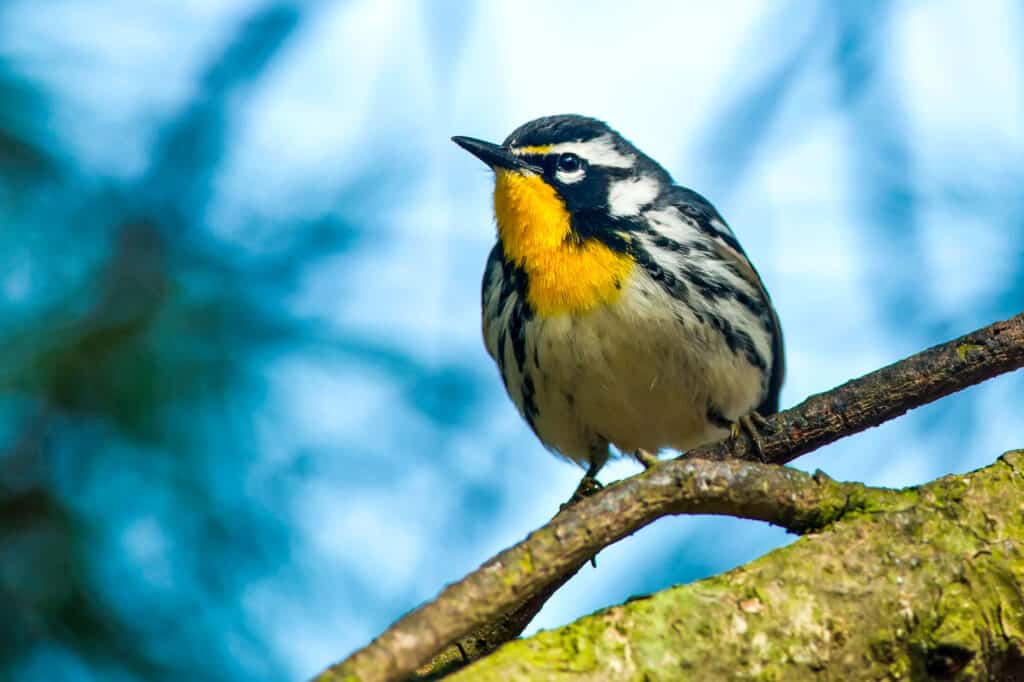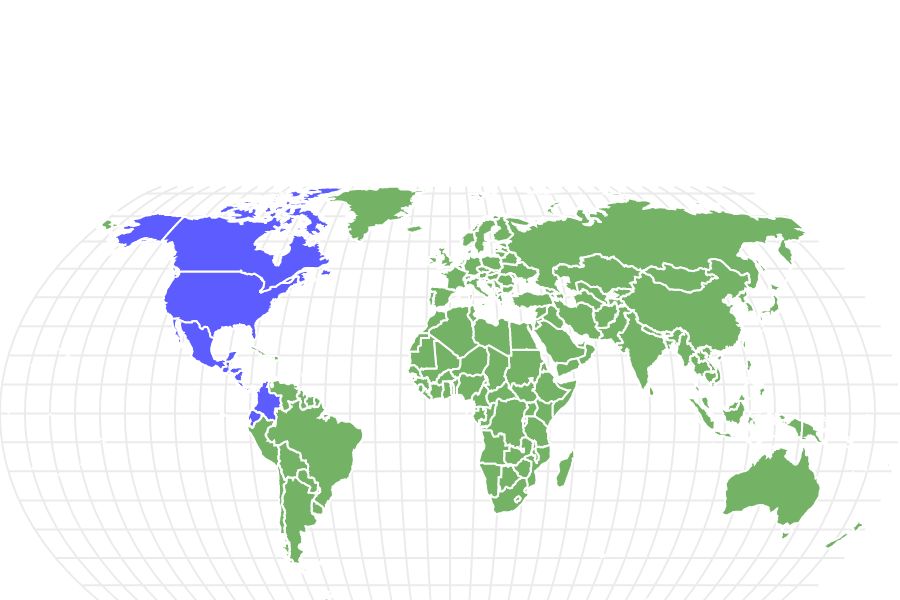Yellowthroat
Geothlypis trichas, Geothlypis beldingi, and others
They forage near the ground, searching leaves for insects
Advertisement
Yellowthroat Scientific Classification
- Kingdom
- Animalia
- Phylum
- Chordata
- Class
- Aves
- Order
- Passeriformes
- Family
- Parulidae
- Genus
- Geothlypis
- Scientific Name
- Geothlypis trichas, Geothlypis beldingi, and others
Read our Complete Guide to Classification of Animals.
Yellowthroat Conservation Status
Yellowthroat Facts
- Prey
- Grasshoppers, dragonflies, mayflies, beetles, spiders, ants
- Main Prey
- Insects
- Name Of Young
- Chicks
- Group Behavior
- Mainly solitary
- Fun Fact
- They forage near the ground, searching leaves for insects
- Estimated Population Size
- Unknown
- Biggest Threat
- Habitat loss from urbanization and wildfires
- Most Distinctive Feature
- Black face masks
- Distinctive Feature
- round heads, thick necks
- Wingspan
- 5 to 8 inches
- Incubation Period
- 12 days
- Age Of Fledgling
- 8 to 12 days
- Habitat
- Marshes and other wetlands
- Predators
- Hawks, northern harriers, and merlins
- Diet
- Insectivore
- Lifestyle
- Diurnal
- Type
- Bird
- Common Name
- Yellowthroat
- Special Features
- Loud, fast calls
- Number Of Species
- 12
- Location
- North America, Central America, South America
- Nesting Location
- low vegetation like grasses, reeds, cattails, and sedges
- Migratory
- 1
View all of the Yellowthroat images!
“Yellowthroats are curious birds attracted to repetitive noises.”
Summary
The yellowthroat is a common songbird from the wood-warbler family. They have an extensive range across two continents and over 40 countries. These birds inhabit marshes and wetlands in open spaces, where they stay low to the ground to avoid predators and to search for food. Look for their yellow-olive color in the dense vegetation and listen for their loud, fast calls. Learn everything there is to know about them, including where they live, what they eat, and how they behave.
5 Amazing Yellowthroat Facts
- Yellowthroats live in low, dense vegetation, typically in wetlands with plenty of cover for protection.
- They forage near the ground, searching leaves and flowers for insects.
- Males defend their territories against other male songbirds, and females defend against other females.
- Two species are vulnerable to habitat loss from wildfires, reed cutting, and construction.
- The longest-living yellowthroat was over 11 years old!
Where to Find the Yellowthroat
The yellowthroat lives in over 40 countries across North and South America, including Canada, the United States, Mexico, the Bahamas, and Costa Rica. Many species are year-round residents in their Central American and South American homes. In contrast, others breed in the northern parts of North America (Canada and the United States) before heading south to Mexico, Central, and South America for the winter. They mostly live in marshes and other wetlands with low, dense greenery. Some live in prairies, pine forests, thickets, orchards, fields, river edges, and disturbed areas. To find these birds, look in bushes of open spaces and find their yellow-green coloring among the plants.
Locations
- North America: Canada, US, Mexico, the Bahamas
- Central America: Costa Rica, Colombia, Ecuador, Honduras, Nicaragua, Panama, Belize, El Salvador
- South America
Yellowthroat Nest
Females select their nesting site on the ground in low plant life like grasses, reeds, cattails, and sedges. Once she chooses the perfect hiding area, it takes her four to five days to build. She weaves a loose cup of leaves and grasses and lines the inside with grass, bark fiber, and animal hair.
Scientific Name
The yellowthroat (Geothlypis) are New World warblers endemic to the Americas. They are from the Parulidae family, which includes small, colorful passerine birds or “wood-warblers.” This genus contains 12 species:
- Common yellowthroat
- Belding’s yellowthroat
- Altamira yellowthroat
- Bahama yellowthroat
- Olive-crowned yellowthroat
- Black-polled yellowthroat
- Masked yellowthroat
- Gray-crowned yellowthroat
- Hooded yellowthroat
- MacGillivray’s warbler
- Mourning warbler
- Kentucky warbler
Size, Appearance, and Behavior
Yellowthroats are small, chunky songbirds with round heads, thick necks, and medium-sized tails. They measure between four and five inches and weigh 0.3 ounces, with a five to eight-inch wingspan. Adult males are a yellow-olive color with black face masks. Females lack face masks and feature an olive-brown color. This species spends most of its time staying low to the ground in dense vegetation, looking for food. Their calls are loud and fast, sounding similar to “witchity-witchity-witchity.” These birds are mostly loners but will forage in mixed flocks sometimes.

These small, round songbirds only weigh around 0.3 ounces.
©iStock.com/PaulReevesPhotography
Migration Pattern and Timing
Yellowthroat species in more southern regions, like Mexico, Central, and South America, are typically year-round residents in their environments. Several species, like the common yellowthroat, are long-distance migrants. They spend their springs and summer (breeding season) in Southern Canada and much of the United States. They migrate to Mexico, Central America, and the Bahamas during winter, but some common yellowthroats in the Southern United States are year-round residents.
Diet
They are mostly insectivores but may sometimes eat seeds.
What Does the Yellowthroat Eat?
Most eat grasshoppers, dragonflies, mayflies, beetles, spiders, ants, termites, bees, wasps, caterpillars, moths, aphids, butterflies, and larvae. They mostly forage near the ground, picking insects off leaves, bark, flowers, and branches.
Predators, Threats, and Conservation Status
The IUCN lists nine out of 12 species as LC or “least concern.” Because of their range and large populations at the present time, they do not qualify for “threatened” status. The Altamira yellowthroat is listed as NT or “near-threatened,” and the black-polled and Belding’s yellowthroats are V or “vulnerable.” Their greatest threats include wildfires, reed cutting for tourism, house construction, drainage for farming, and hurricanes.
What Eats the Yellowthroat?
Adults can fall victim to predatory birds like hawks, eagles, owls, northern harriers, and merlins. They also experience nest predation, especially from snakes, raccoons, and turtles, as well as possums, mice, chipmunks, and skunks. Males will defend their area from other males, and females defend against other females.
Reproduction, Young, and Molting
During mating, males flick their wings and tails, perform flight displays, sing, and follow the female around until she agrees to mate. The male is mostly faithful, but the female sometimes mates with others behind his back. They lay between two and six eggs, and females warm them for around 12 days. Males help by bringing feed and feeding the nestlings. They leave the nest around eight to twelve days after they hatch but rely on their parents for some time. Most species reach their sexual peak by year one and can live up to 11 years in the wild.
Population
The global population of all yellowthroat species is unknown; however, the common yellowthroat alone has over 77 million mature individuals in their range. Seven out of 12 species are experiencing a drop in numbers, three are stable, and two have growing populations. The black-polled and Belding’s yellowthroats have the most significant population drop, most likely from habitat loss.
Up Next:
View all 32 animals that start with YYellowthroat FAQs (Frequently Asked Questions)
What kind of bird is a yellowthroat?
Yellowthroats are wood-warblers from the Parulidae family.
How do you attract a yellowthroat?
To attract yellowthroats, place dried insects, like crickets and mealworms, on the ground near a bush.
What does a yellowthroat eat?
Yellowthroats eat grasshoppers, dragonflies, mayflies, beetles, spiders, ants, termites, bees, wasps, caterpillars, moths, aphids, butterflies, and larvae.
How big is a yellowthroat?
They measure between four and five inches and weigh 0.3 ounces, with a five to eight-inch wingspan.
What does a yellowthroat look like?
Adult males are a yellow-olive color with black face masks. Females lack face masks and feature an olive-brown color.
What bird looks like it has a mask on?
Male yellowthroats are a yellowish-olive color with black face masks. The females do not have masks.
How many eggs does a yellowthroat lay?
Yellowthroats lay between two and six eggs, and females incubate them for around 12 days.
Thank you for reading! Have some feedback for us? Contact the AZ Animals editorial team.
Sources
- , Available here: https://www.iucnredlist.org/search?query=yellow%20throat&searchType=species
- Robert E Stewart, Available here: https://www.jstor.org/stable/4158186
- Missouri Department of Conservation, Available here: https://education.mdc.mo.gov/discover-nature/field-guide/common-yellowthroat

















